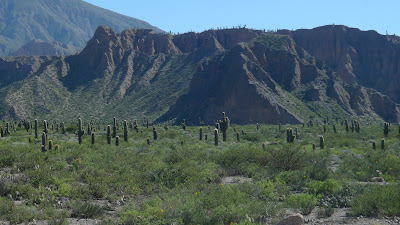Mom Morrow- Yes, Seth is holding towels and probably a toothbrush in the last picture of Mendoza...haha. We had just gotten back from our day at the hotsprings and were walking around downtown.
After our two days in La Cumbrecita we returned to Cordoba and stayed there one more night. The next day we took an overnight bus to Salta which is up in the northern part of Argentina. The morning we got there, we walked around town and got settled in a hostel. The rest of the afternoon we spent seeing things around the city center. We took a gondola ride to the top of a hill where there is a park with great views. We also went to an archaeology museum where they have three Incan mummies that were found on the top of a nearby volcano in March 1999. All three mummies were children that had been sacrificed in religious ceremonies on top of the volcano. Because of the altitude where they were found, the bodies were really well preserved, along with some artifacts that were buried with them such as miniature llama figurines and slingshots. One of the bodies was on display for us to see. Very interesting. And very creepy. Unfortunately, we don´t have any pictures of the mummy becuase one of the museum guards came and made me delete the ones I had taken. Oops. I thought pictures were allowed as long as I didn´t use a flash. Apparently not. That evening we walked around a street market and enjoyed some local food.
After our two days in La Cumbrecita we returned to Cordoba and stayed there one more night. The next day we took an overnight bus to Salta which is up in the northern part of Argentina. The morning we got there, we walked around town and got settled in a hostel. The rest of the afternoon we spent seeing things around the city center. We took a gondola ride to the top of a hill where there is a park with great views. We also went to an archaeology museum where they have three Incan mummies that were found on the top of a nearby volcano in March 1999. All three mummies were children that had been sacrificed in religious ceremonies on top of the volcano. Because of the altitude where they were found, the bodies were really well preserved, along with some artifacts that were buried with them such as miniature llama figurines and slingshots. One of the bodies was on display for us to see. Very interesting. And very creepy. Unfortunately, we don´t have any pictures of the mummy becuase one of the museum guards came and made me delete the ones I had taken. Oops. I thought pictures were allowed as long as I didn´t use a flash. Apparently not. That evening we walked around a street market and enjoyed some local food.
gondola ride over Salta
a park right next to the street fair
Seth trying to reach an orange from an orange tree on the street. If they´re on the street they´re free, right?
The next day we took an all-day tour of several places around Jujuy. Jujuy is about 2 hours north of Salta. The farther north we went, Argentina started looking more and more like Bolivia. The towns we visited around Jujuy have indigenous roots, where the rest of Argentina´s roots are more European. The people were shorter and have darker skin. A lot of the native culture still exists here; most everyone speaks Spanish and Quechua and the dress was much more traditional than we had seen so far. The tour took us to four or five different places, where we had between 30 minutes and an hour to walk around. It was a great way for us to see a lot of places in only one day.
The first place we went to was the tiny village of Purmamarca. Right on the edge of town is the Mountain of Seven Colors. We also stopped at the Tropic of Capricorn to take pictures. We had lunch in another town called Humahuaca. Seth tried the llama and it was pretty good. We were also taken to a little family-run pottery place. It has been run by the same family for four generations and we got to see the pottery-making process from start to finish. One of our last stops was to a Pucará (fortress). A pucará is a town built on top of a hill that is naturally protected by it´s steep sides. Pucarás were strategically placed within eyesight of each other along the valleys so that villages could communicate with each other. Most ways of communicating were by using fire signals or reflecting sunlight off of shiny rocks. The one we visited was also used as a major center of trade because of its location connecting three valleys.
pet llama in Purmamarca
Cerro de Siete Colores (Mountain of Seven Colors) in Purmamarca
scenery on the drive
Tropic of Capricorn. This is a huge sundial built right on the 23.5º S latitude line. The surrounding villages still gather here every June 21st when the sun is directly overhead and casts no shadow. They consider this their new year and celebrate until dawn of the next day.
Purmamarca
Humahuaca
Monument of Heroes in Humahuaca
It was incredible to see how fast these bowls were made. Each bowl only took about 5-10 seconds.
The Humahuaca Gorge from the top of the pucará. This is one of the valleys that this pucará connected.
One of the houses on the pucará. They were clearly not made six feet tall Americans.
La Parada del Pintor (The Painter´s Stop)














Beautiful scenery, I love La Parada del Pinto! AMAZING...... Seth, you should visit a produce market, I taught you not to steal!!!! LOL
ReplyDelete